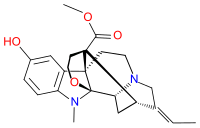
| |
| Names | |
|---|---|
| Other names Vincamajoridine | |
| Identifiers | |
| CAS Number | |
| 3D model (JSmol) | |
| ChEMBL | |
| ChemSpider | |
| PubChem CID | |
| UNII | |
InChI
| |
SMILES
| |
| Properties | |
| Chemical formula | C22H26N2O4 |
| Molar mass | 382.460 g·mol |
| Melting point | 225 °C (437 °F; 498 K) |
| Except where otherwise noted, data are given for materials in their standard state (at 25 °C , 100 kPa).
| |
Akuammine (vincamajoridine) is an indole alkaloid. It is the most abundant alkaloid found in the seeds from the tree Picralima nitida, commonly known as akuamma, comprising 0.56% of the dried powder. It has also been isolated from Vinca major. Akuammine is structurally related to yohimbine, mitragynine and more distantly Voacangine, all of which are alkaloid plant products with pharmacological properties.
Pharmacology
Akuammine has antimalarial activity, and may be the primary constituent of P. nitida seeds responsible for this activity.
Akuammine is an opioid agonist with low affinity, selective for the mu-opioid receptor, when tested in vitro.
References
- Merck Index (12th ed.). 200.
- ^ Janot MM, Le Men J, Aghoramurthy K, Robinson R (September 1955). "The identity of vincamajoridine and akuammine". Experientia. 11 (9): 343. doi:10.1007/BF02159911. PMID 13262018.
- ^ Kapadia GJ, Angerhofer CK, Ansa-Asamoah R (December 1993). "Akuammine: an antimalarial indolemonoterpene alkaloid of Picralima nitida seeds". Planta Medica. 59 (6): 565–6. doi:10.1055/s-2006-959764. PMID 8302957. S2CID 260253044.
- Neuwinger HD (1996). African Ethnobotany: Poisons and Drugs : Chemistry, Pharmacology, Toxicology. CRC Press. p. 123. ISBN 9783826100772.
- Menzies JR, Paterson SJ, Duwiejua M, Corbett AD (May 1998). "Opioid activity of alkaloids extracted from Picralima nitida (fam. Apocynaceae)". European Journal of Pharmacology. 350 (1): 101–8. doi:10.1016/s0014-2999(98)00232-5. PMID 9683021.
- Lewin G, Le Ménez P, Rolland Y, Renouard A, Giesen-Crouse E (March 1992). "Akuammine and dihydroakuammine, two indolomonoterpene alkaloids displaying affinity for opioid receptors". Journal of Natural Products. 55 (3): 380–4. doi:10.1021/np50081a017. PMID 1317407.